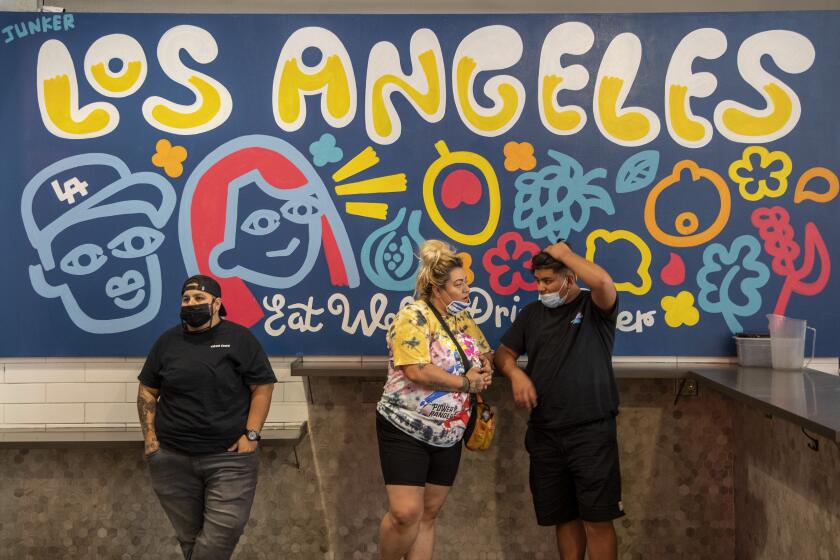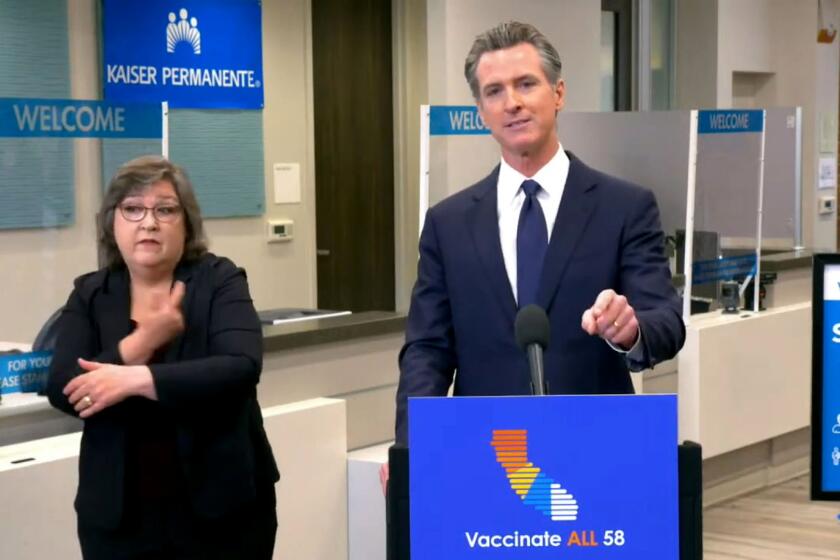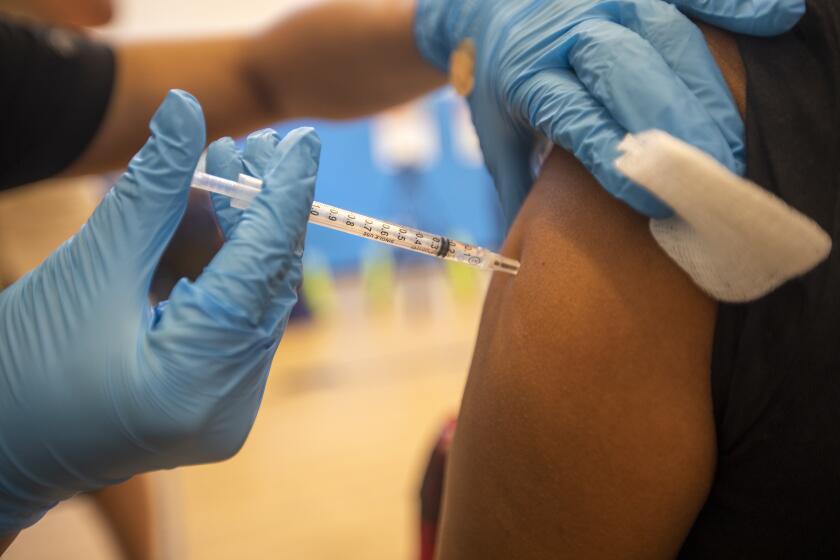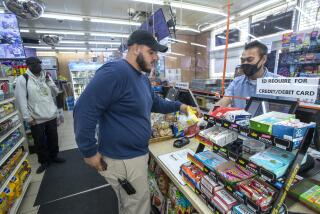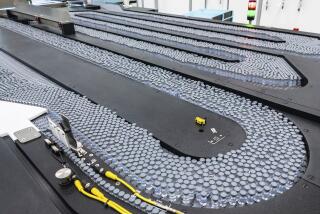California sees small boost in vaccinations but needs much more
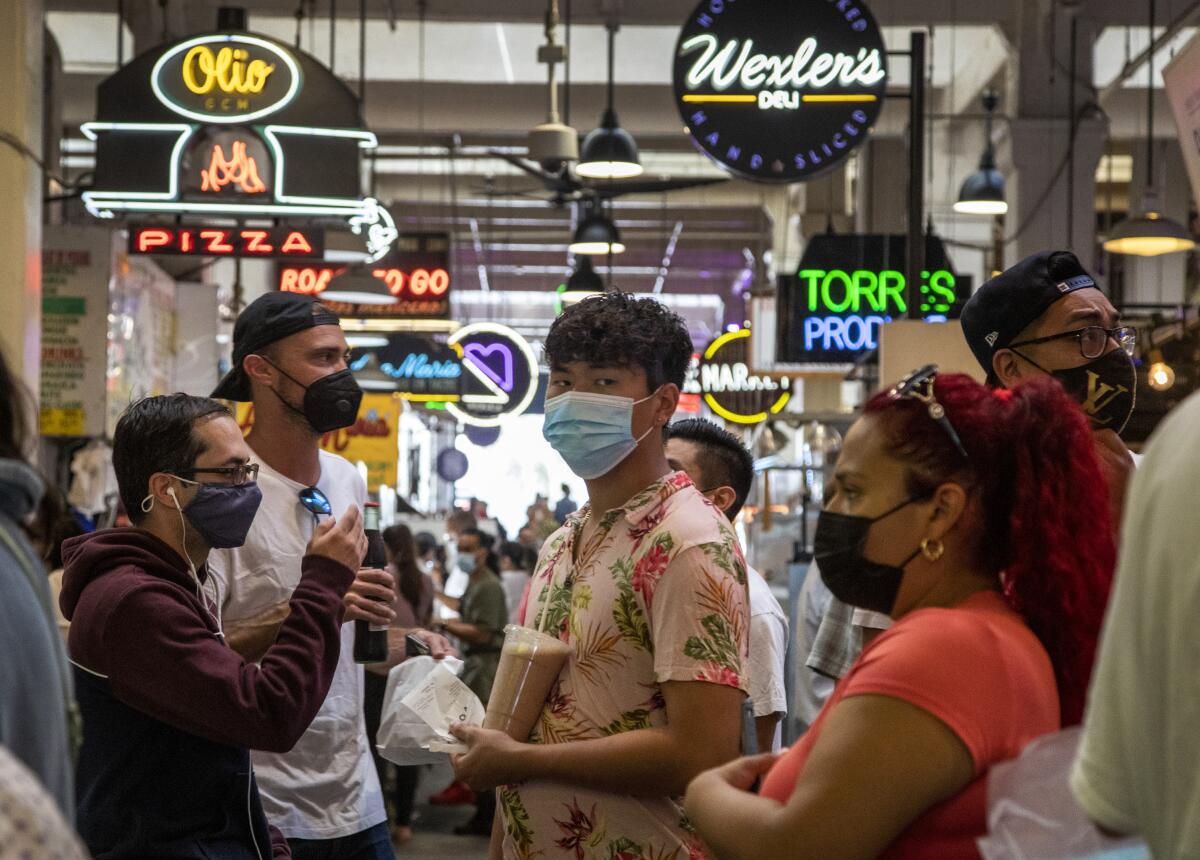
- Share via
With California’s summer coronavirus surge worsening, officials are unveiling new rules, redoubling efforts to get more people to wear masks and even employing some pointed remarks as part of an urgent campaign to boost vaccinations and slow the rapid spread of the highly infectious Delta variant.
The state Wednesday urged everyone — even those fully vaccinated against COVID-19 — to wear masks indoors while in public, joining a renewed national push to increase protection amid an ongoing spike in cases.
But the ultimate goal is to convince those who have not been vaccinated to get their shots, which experts say is vital to reverse the surge.
And there are some early signs of movement among Californians who, to this point, have remained on the fence.
From July 18 to 24, providers throughout the state administered an average of just more than 64,000 vaccines a day — about 3,100 more daily doses than the week before.
At first glance, a 5% increase doesn’t seem that significant. But officials say any uptick is welcome.
“Our sense of urgency to increase vaccination amongst residents remains very high, and we’re glad for any signs of increased vaccination uptake,” L.A. County Public Health Director Barbara Ferrer said.
About 53% of Californians are fully vaccinated against COVID-19, according to data compiled by The Times.
A bigger slice of the state, about 61%, has received at least one vaccine dose. But officials emphasize that it’s vital for anyone who received their first shot of Pfizer-BioNTech or Moderna to complete their vaccine regimen so they can be as protected as possible.
Getting more people vaccinated remains a challenging — and individualized — puzzle, and health officials have stepped up community clinics, mobile immunization programs and community outreach.
But given the latest resurgence of the coronavirus, some officials are more regularly voicing their frustrations with those who have yet to roll up their sleeves.
The new recommendation appears to be more expansive than the latest guidance from the U.S. Centers for Disease Control and Prevention.
Earlier this week, Gov. Gavin Newsom went so far as to compare choosing to remain unvaccinated to driving while drunk.
“We’re at a point in this epidemic, this pandemic, where choice — individuals’ choice not to get vaccinated — is now impacting the rest of us in a profound and devastating and deadly way,” he said.
Los Angeles County Supervisor Sheila Kuehl couldn’t hide her exasperation this week at “all the unvaccinated idiots who are raising the number of cases by their behavior and their choices.”
“This is a public health crisis. I’m not sure what more it takes for people to understand the gravity of this crisis,” Supervisor Holly Mitchell added during the Board of Supervisors’ latest meeting.
The story of California’s COVID-19 vaccination campaign has been one of steady rise, followed by precipitous decline.
The number of shots going into Californians’ arms each day, on average, peaked in mid-April at about 400,000. Since then, the pace has fallen off dramatically.
Newsom appeared frustrated at a Monday news conference in Alameda County, where he announced at a Kaiser Health facility that state employees and healthcare workers will be required to show proof of vaccination or submit to routine testing beginning next month.
Officials and experts have long said there are numerous reasons someone may have delayed getting vaccinated.
Some may be wary of potential side effects, or been unable to make time in their schedules. Others may have balked due to deep-rooted distrust of government or healthcare agencies stemming from systemic inequities and institutional racism.
And a not insignificant number of people adamantly oppose getting vaccinated, for various personal or political reasons.
Even if the state sustains its current vaccination pace, it will probably take months to fully vaccinate the portion of the population thought necessary to achieve herd immunity — the level at which sustained transmission of the virus is interrupted.
Estimates vary, but experts generally believe between 70% and 85% of the population would need to be vaccinated to achieve long-lasting protection.
California, despite having one of the more robust levels of vaccine coverage in the nation, remains well short of that range.
There’s a white privilege to denouncing everyone who refuses to get a COVID-19 vaccine. For those who are Black, there’s systemic racism to consider.
Over the last week, California has reported a seven-day average of nearly 7,400 new coronavirus cases a day — roughly eight times the rate from four weeks ago, according to data compiled by The Times.
On Tuesday, 3,565 coronavirus-positive patients were hospitalized statewide, with 770 of them in intensive care.
Both figures have doubled within the last two weeks.
Officials stress that the vast majority of new infections are being found in those who are unvaccinated.
From July 14 to 20, the average coronavirus case rate among unvaccinated Californians was 20.7 per 100,000 people per day — about six times the comparable rate of vaccinated individuals, according to state health officials.
But with transmission on the rise, officials say more precautions are warranted.
“It takes two weeks from the time a person gets a dose of Johnson & Johnson vaccine, and six to seven weeks from the time a person gets their first dose of Moderna or Pfizer, before they’re considered fully protected,” Ferrer said this week. “In the meantime, it’s still critically important for those of you coming in to get vaccinated to wear your mask — even if you’re still sporting your ‘just vaccinated’ sticker.”
L.A. County has for weeks required even fully vaccinated residents to mask up while in public indoor spaces as an extra precaution to stymie transmission.
A growing number of government agencies are requiring employees to provide proof of vaccination against COVID-19 or undergo regular testing.
State health officials Wednesday urged — but did not mandate — all Californians to do the same.
The new recommendation appears to be more expansive than the latest guidance from the U.S. Centers for Disease Control and Prevention. That agency advised Tuesday that residents wear masks indoors while in public in areas where community transmission is considered substantial or high, the two worst classifications on the agency’s four-tier scale.
Most of California fell into one of those categories as of Wednesday, including the entire southern third of the state. And more than 90% of California’s population lives in areas under one of those designations, according to the state Department of Public Health.
“The Delta variant has caused a sharp increase in hospitalizations and case rates across the state. We are recommending masking in indoor public places to slow the spread while we continue efforts to get more Californians vaccinated,” Dr. Tomás Aragón, director of the California Department of Public Health and state public health officer, said in a statement.
More to Read
Sign up for Essential California
The most important California stories and recommendations in your inbox every morning.
You may occasionally receive promotional content from the Los Angeles Times.
